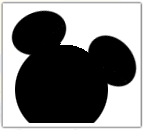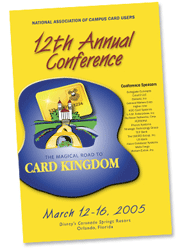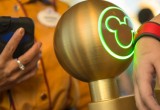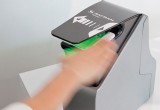Biometrics at the Disney Gates
02 March, 2006
category: Biometrics, Education, Library
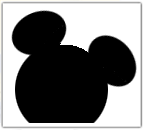 By David Wyld, Contributing Editor, AVISIAN Publications
By David Wyld, Contributing Editor, AVISIAN Publications
When visitors step up to the gates of the four Disney World theme parks, the Magic Kingdom, Epcot, Animal Kingdom, or the MGM Studios, they will encounter something unexpected and largely foreign to them. Disney has embarked on a program to use an established biometric technology – finger geometry – to secure its valuable passes. Ostensibly, this new security is for the benefit of the pass owner. However, it is also being implemented to secure Disney’s pricing structure and marketing strategy. It has not come without controversy – and at least a bit of confusion.
What is Finger Geometry?
Hand geometry has been aptly described as “the ‘granddaddy’ of all biometric technology devices.” It is essentially based on the fact that virtually every individual’s hand is shaped differently than another individual’s hand, and over the course of time, the shape of the person’s hand does not significantly change. Operationally, finger or hand scanning systems capture the physical, geometric characteristics of an individual’s hand – with most systems having the capacity to do so in less than a second. From these measurements, a profile or “template” is constructed which will be used to compare against subsequent readings by the user. Finger and hand geometry are considered somewhat interchangeable terms. However, hand geometry evaluates the person’s entire hand form as a biometric identifier, while finger geometry looks only at a subset of the five fingers to form the identifier. In either case, such geometry does not entail the taking of a person’s fingerprints. In a recent study, the National Academies of Science of Science found that while a person’s finger geometry is indeed far less distinctive than his/her fingerprints, hand or figure biometrics is indeed suitable as an identifier for a wide variety of circumstances, where one in a thousand uniqueness is sufficient.
Finger geometry has been used successfully since its commercial introduction in 1975, when it was brought to Wall Street for security purposes by the investment firm of Shearson Hamill. Over the years, it has been utilized to provide secure access and verify one’s identity in a wide variety of settings, including:
- Athletes at Olympic Villages
- Members of the Colombian National Legislature
- Employees of over 90% of all nuclear power plants in the U.S.A.
- Military officers
- Prisoners
- Parents at day care centers, and
- Donors at sperm clinics.
Probably the widest use of finger or hand scanning is in the corporate realm, where such scanning is used in complement with employee badges, passes, and ID cards to prevent payroll fraud, a seemingly intransigent problem which has been estimated to cost employers in the U.S. alone hundreds of millions of dollars each year. While other forms of biometrics may be growing more rapidly, there is still substantial growth potential for hand and finger scanning, In fact, according to Biometrics Info, hand geometry revenues have been forecast to reach $97.4 million in 2007, which represents an almost 400% growth in the market since 2002.
Giving Disney Your Fingers
Disney has moved over the past decade to use automatic identification in various forms. In 1996, the company moved away from a hard plastic laminated pass for all holders of multiday or annual passes, which contained both a bar code identifier and a photo of the passholder. In its place, Disney began issuing mylar paper passes. These new passes had no photo identifier, and indeed, contained only minimal visual evidence of ownership, basically only the guest’s name and the expiration date of the pass. Beginning in June 2005, all Walt Disney World parks began using finger scanning at its park entrances to complement the security measures embedded in its mylar passes. When a Disney guest presents his pass at the turnstile, he is asked to insert the pass into a reader, and after doing so, to make a “peace sign” with his index and middle fingers and insert those fingers into a scanning area. During the scan, a camera takes a picture of several points on each person’s index and middle fingers and assigns a numerical value to the image. The scan – which is accomplished in less than a second – measures the length and width of the individual’s two fingers and the spread distance between the digits. Once the scan is taken – and all adults are required to do so – the pass is returned to the guest.
For a number of years now, Disney’s marketing approach has been to shrewdly push the sale of multi-day and annual passes to its theme parks that comprise the Disney World complex (Disney passes are not interchangeable between its parks in Anaheim, California and Orlando, Florida). The pricing structure at Disney World’s is transparently meant to encourage its visitors to buy passes for longer stays at its Orlando properties. In fact, the daily price of a Disney park visit drops significantly as longer-lasting park passes are purchased – by half at the 7-day mark and by almost two-thirds at the ten day market. To put it quite simply, Disney makes about $200 more by selling five separate two-day tickets than by selling a single ten-day pass. So, to protect its revenue stream, Disney does not allow its annual or multi-day passes to be shared or transferred. They don’t want people to buy a ten-day pass, use it for two days, and then resell the pass to a buyer to use the remaining days.
Not only do longer stays mean that families visiting Disney World will have more opportunities to spend more money on food and beverages, souvenirs and trinkets, and other experiences, such as breakfast with Cinderella, while on Disney property. Perhaps even more importantly, the passes serve to “lock-in” guests to focus their Orlando visits on Disney parks, rather than spending their time – and money – at the competitor’s parks and other entertainment experiences available in this burgeoning family resort area.
A mixed reaction
From Disney’s perspective, the ticket tag is a necessary security measure that does not violate its customers’ privacy. According to Disney spokeswoman Kim Prunty, contrary to some reports, “We’re not keeping a database of fingerprints.” In fact, the company does not maintain a permanent database of scans, as the information is purged from its systems after the individual’s pass expires. Disney has also not disclosed the vendor for its biometric system.
However, Disney’s move to finger scanning has generated some degree of controversy since its implementation. Since Disney defines an “adult” park guest as being 10 or older, many minors are being subjected to finger scanning. Leading privacy groups have also attacked Disney’s move. The American Civil Liberties Union recently called the addition of biometric technology “a step in the wrong direction.” EPIC – the Electronic Privacy Information Center – recently issued a blistering attack on Disney for its use of finger scanning. It called the practice a “a gross violation of privacy rights,” as there is little notice given to consumers as to why their biometric information is being collected, how it will be used, and the protection afforded to the data. EPIC also criticized Disney’s move based on the legal principle known as “the proportionality test,” which can be encapsulized as whether the amount and type of information being collected equals the level of security being sought? To date however, there have been no lawsuits filed against Disney over its use of finger scanning technology.
Surprisingly, both at ticket sales’ locations and at the actual park entry points, Disney has not seen fit to post information on exactly what is being done when the park patrons are asked to make the peace sign and insert their digits into the reading machine. Most patrons – and even some public interest groups and media covering the developments at Disney – have assumed that the company is fingerprinting park visitors and matching the passholder’s print to the pass – and perhaps even other databases, such as criminal records, sex offender registries, and terror watch lists. This has led some industry observers to criticize Disney for having a corporate communications problem in not explaining the “why’s” for the use of the technology to its patrons, while others have seen fit to call upon Disney to find creative ways to leverage the technology – and the data it collects – beyond gate security to provide better in-park customer experiences for its guests.
Good technology often makes good business sense
What is certain is that we will see more such applications of finger geometry in the future, as Disney is by no means alone in exploring how this established technology in the theme park industry. Indeed, according to a report from The Orlando Sentinel, several of the company’s principal competitors are looking to implement similar pass protection technology to their valuable tickets and passes in 2006, including:
- Universal Orlando
- SeaWorld Adventure Parks
- Paramount Theme Parks.
From the perspective of Dennis Speigel, President of International Theme Park Services in Cincinnati, such biometric scanning may be a necessary tool for the entire theme park industry. He recently observed that: “Tickets are very expensive for these facilities. If you can hand them off, it costs the parks money. The introduction (of this type of solution) will be used more broadly in the industry in the future.”
For now, the introduction of finger scanning seems to present Disney with an operational challenge to get visitors used to the new requirement. The reaction of Simon Henson, who visited Disney while on vacation, is common. As Mr. Henson put it: “Overall it’s good. But it seems to make the queues longer. No one seems to put their fingers in all the way on the first try.”
About the author:
David C. Wyld ([email protected]) is the Maurin Professor of Management and Director of the Strategic e-Commerce/e-Government Initiative at Southeastern Louisiana University.

